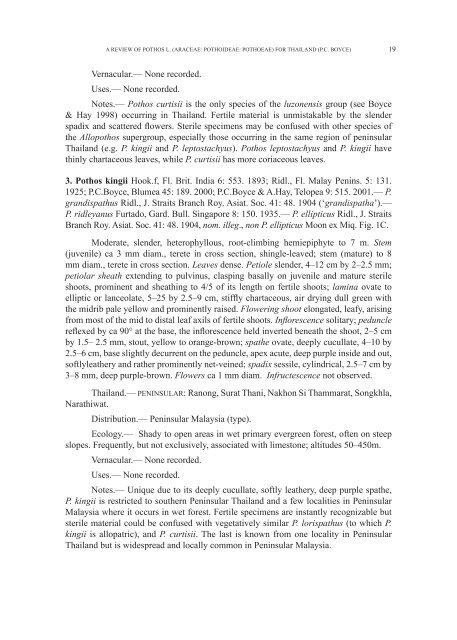You also want an ePaper? Increase the reach of your titles
YUMPU automatically turns print PDFs into web optimized ePapers that Google loves.
A REVIEW OF POTHOS L. (ARACEAE: POTHOIDEAE: POTHOEAE) FOR <strong>THAI</strong>LAND (P.C. BOYCE)<br />
Vernacular.— None recorded.<br />
Uses.— None recorded.<br />
Notes.— Pothos curtisii is the only species of the luzonensis group (see Boyce<br />
& Hay 1998) occurring in Thailand. Fertile material is unmistakable by the slender<br />
spadix and scattered flowers. Sterile specimens may be confused with other species of<br />
the Allopothos supergroup, especially those occurring in the same region of peninsular<br />
Thailand (e.g. P. kingii and P. leptostachyus). Pothos leptostachyus and P. kingii have<br />
thinly chartaceous leaves, while P. curtisii has more coriaceous leaves.<br />
3. Pothos kingii Hook.f, Fl. Brit. India 6: 553. 1893; Ridl., Fl. Malay Penins. 5: 131.<br />
1925; P.C.Boyce, Blumea 45: 189. 2000; P.C.Boyce & A.Hay, Telopea 9: 515. 2001.— P.<br />
grandispathus Ridl., J. Straits Branch Roy. Asiat. Soc. 41: 48. 1904 (‘grandispatha’).—<br />
P. ridleyanus Furtado, Gard. Bull. Singapore 8: 150. 1935.— P. ellipticus Ridl., J. Straits<br />
Branch Roy. Asiat. Soc. 41: 48. 1904, nom. illeg., non P. ellipticus Moon ex Miq. Fig. 1C.<br />
Moderate, slender, heterophyllous, root-climbing hemiepiphyte to 7 m. Stem<br />
(juvenile) ca 3 mm diam., terete in cross section, shingle-leaved; stem (mature) to 8<br />
mm diam., terete in cross section. Leaves dense. Petiole slender, 4–12 cm by 2–2.5 mm;<br />
petiolar sheath extending to pulvinus, clasping basally on juvenile and mature sterile<br />
shoots, prominent and sheathing to 4/5 of its length on fertile shoots; lamina ovate to<br />
elliptic or lanceolate, 5–25 by 2.5–9 cm, stiffly chartaceous, air drying dull green with<br />
the midrib pale yellow and prominently raised. Flowering shoot elongated, leafy, arising<br />
from most of the mid to distal leaf axils of fertile shoots. Inflorescence solitary; peduncle<br />
reflexed by ca 90° at the base, the inflorescence held inverted beneath the shoot, 2–5 cm<br />
by 1.5– 2.5 mm, stout, yellow to orange-brown; spathe ovate, deeply cucullate, 4–10 by<br />
2.5–6 cm, base slightly decurrent on the peduncle, apex acute, deep purple inside and out,<br />
softlyleathery and rather prominently net-veined; spadix sessile, cylindrical, 2.5–7 cm by<br />
3–8 mm, deep purple-brown. Flowers ca 1 mm diam. Infructescence not observed.<br />
Thailand.— PENINSULAR: Ranong, Surat Thani, Nakhon Si Thammarat, Songkhla,<br />
Narathiwat.<br />
Distribution.— Peninsular Malaysia (type).<br />
Ecology.— Shady to open areas in wet primary evergreen forest, often on steep<br />
slopes. Frequently, but not exclusively, associated with limestone; altitudes 50–450m.<br />
Vernacular.— None recorded.<br />
Uses.— None recorded.<br />
Notes.— Unique due to its deeply cucullate, softly leathery, deep purple spathe,<br />
P. kingii is restricted to southern Peninsular Thailand and a few localities in Peninsular<br />
Malaysia where it occurs in wet forest. Fertile specimens are instantly recognizable but<br />
sterile material could be confused with vegetatively similar P. lorispathus (to which P.<br />
kingii is allopatric), and P. curtisii. The last is known from one locality in Peninsular<br />
Thailand but is widespread and locally common in Peninsular Malaysia.<br />
19
















